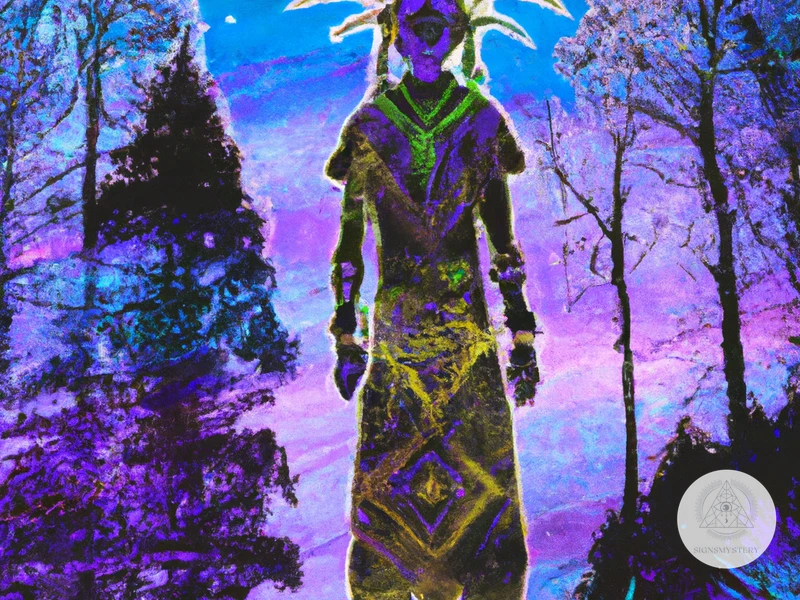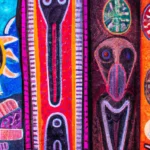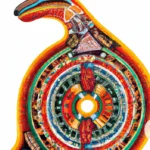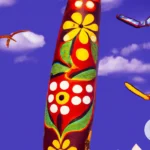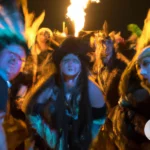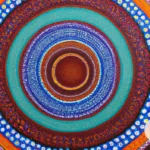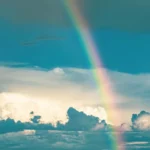As one of the oldest living cultures on the planet, the Aboriginal people of Australia have a rich and fascinating spiritual tradition that spans tens of thousands of years. At the heart of this tradition lies shamanism, an ancient practice that involves connecting with the spiritual world through a combination of ritual, ceremony, and trance-like states of consciousness. From creation myths and totems to powerful spiritual beings like the Rainbow Serpent and the Wandjina, Aboriginal shamanism is a complex and deeply mystical tradition that has captivated the imaginations of people around the world. In this article, we will explore the myths and legends that make up this unique spiritual path, as well as the rituals and traditions that have endured through centuries of colonization and social change.
Ancient Beliefs and Practices
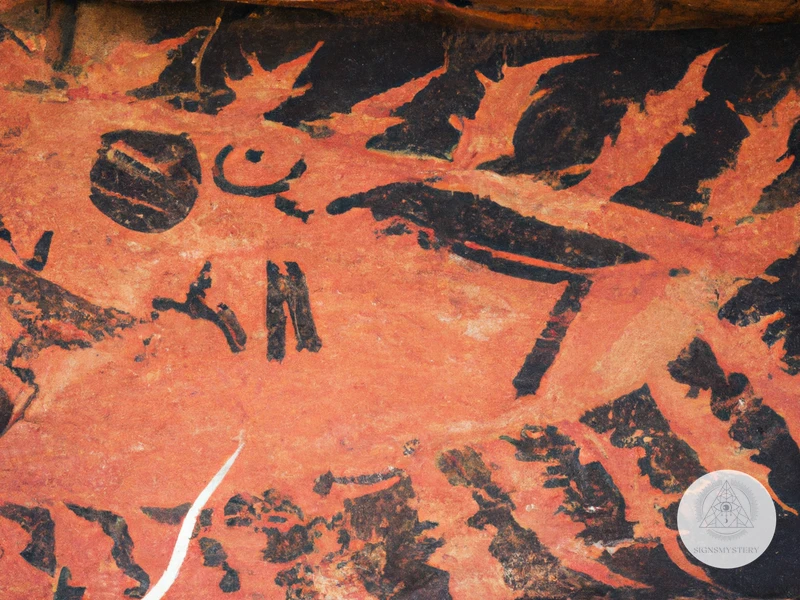
Beliefs and practices deeply rooted in mythologies and rituals have always been an essential part of Aboriginal culture. Creation myths conveyed the idea that the world was created through the actions of ancestral spirits and beings, and as a result, the land became a sacred entity to be respected and cared for. The Dreamtime was a significant concept that described a timeless place beyond the material world where the spirits resided. It was believed that all life emerged from the Dreamtime, and therefore it played a crucial role in Aboriginal life. Totems and taboos were also integral components of Aboriginal belief systems. Totems were believed to have a spiritual connection to the individual, and they were often associated with certain areas, plants or animals. Breaking a taboo was thought to bring harm to the community and went against the natural order. The unique beliefs and practices of Aboriginal shamanism are a fascinating insight into the spiritual world and its influence on Indigenous Australian culture.
Creation Myths
form the cornerstone of Aboriginal Shamanism and hold a pivotal role in understanding their beliefs. According to their mythology, their ancestors relied on the creation stories to make sense of the world. One of the central stories of Aboriginal Shamanism is that of the Rainbow Serpent, who moved across the land, creating mountains, rivers, waterholes, and gorges. According to the myth, the Rainbow Serpent is responsible for creating the world and all that is in it.
Another creation myth in Aboriginal Shamanism is the story of the Dreamtime. This is the story of how the creator spirits made the world as the Aborigines know it today. The Dreamtime is the foundational story of Aboriginal Shamanism, and it tells of how the world was created and how the spirits of the ancestors passed through the world and left their mark on it.
Aboriginal Shamanism also involves Totems and Taboos, which are symbols of particular animals that represent the spiritual connection between the Aborigines and the natural world. The totem animal has specific powers that can be called upon by the shaman during certain ceremonies. Certain animals are considered taboo, and bringing harm to any of the totem animals is regarded as a crime in Aboriginal culture.
The creation myths in Aboriginal Shamanism are not just static stories. They are living, breathing entities, infused with deep spiritual meaning and significance. They provide a foundation for understanding the Aboriginal people and their relationship with the natural world around them. Aboriginal Shamanism teaches us that everything in the world is interconnected, and the creation myths illustrate this concept beautifully.
The Dreamtime
is a central concept in Australian Aboriginal spirituality. It refers to a time before time, when the world was created by the Ancestral Beings or The Dreaming. The Dreamtime stories are passed down orally from generation to generation and they provide meaning and understanding about how the world came to be and how humans and animals emerged.
According to Aboriginal belief, the Dreaming is an ongoing process and it exists in the present as well as the past. The Ancestral Beings live on in the landscape as sacred sites and landmarks, and it is the responsibility of the current generation to care for them and maintain the balance and harmony of the world.
During the Dreamtime, the Ancestral Beings created the landscape, the animals, and the plants. They also established laws and taboos that governed human behavior. These laws were passed down through the generations through stories and ceremonies.
Aboriginal people believe that the Dreamtime is a living reality and they participate in it through ceremonies, songs, and dances. They also have a strong connection to their ancestral lands, which they call their country. The land is seen as a living entity, with a spiritual power that connects all living things.
The Dreamtime stories are rich in symbolism and metaphor, and they often feature animal spirits such as the kangaroo, emu, and crocodile. These animals are seen as spiritual guides and teachers, and they provide wisdom and knowledge to those who seek it.
In Aboriginal culture, the Dreamtime is not separate from everyday reality, but rather it is an integral part of it. By understanding the Dreamtime, one can better understand the world and their place in it.
The Dreamtime is a complex and fascinating concept that provides insight into the rich spiritual traditions of Australian Aboriginal culture. Its stories and teachings continue to inspire and inform Aboriginal people today, as well as non-Aboriginal people who are interested in learning more about this ancient and enduring culture.
Totems and Taboos
In Australian Aboriginal Shamanism, totems play a central role. A totem is an animal, plant or natural object that a person is descended from and this object is considered as a kind of spiritual emblem. A totem is thought to have a specific spiritual energy that connects with the person who has that totem, and it is believed that a person’s totem can predict their compatibility with other people, their personality traits and their future.
However, totems aren’t just personal spiritual emblems. They’re also used to mark territories and differentiate between groups or clans. Members of a particular clan are believed to share the same totem and have a spiritual obligation to take care of that animal or plant. Blasphemy against one’s totem is considered as a grave offence and may lead to retribution from the spiritual world.
Taboos are also an important part of Aboriginal Shamanism. They’re rules and restrictions that need to be followed in order to avoid loosing a spiritual link to the sacred world. The violation of a taboo can cause a disconnection from spiritual realities and cause disease or death. For example, a person isn’t allowed to marry a person from their own clan or eat an animal that’s considered as their totem. These taboos reflect the close connection between the natural world and the spiritual world in Aboriginal Shamanism.
Interestingly, the concept of totems has been found in other cultures as well. Native American Shamanism has used animal spirits as a part of their legends – (read more on this topic here). Whereas, Norse mythology has elements of Shamanism centered around totem-like objects called fylgjur, that spiritually represent a person’s destiny or animal guide – (more on this topic here). On the other hand, Korean Shamanism has many taboos that must be followed in order to keep a spiritual relationship with the sacred world – (read more about Korean Shamanism here).
Spiritual Beings
In Australian Aboriginal Shamanism, spiritual beings play a key role in their beliefs and practices. These beings are often connected to specific land features or aspects of nature. Among these beings are the powerful Rainbow Serpent, who is believed to have created the land and the people. The Wandjina are another prominent spiritual entity, known for their role as creators and protectors. The elusive Yowie, on the other hand, is a mysterious creature said to inhabit remote regions of the outback. Each of these beings hold their own unique significance and meaning in Aboriginal shamanism, creating a complex and fascinating spiritual world. The beliefs surrounding these beings are passed down through generations, and continue to be an integral part of Aboriginal culture today.
The Rainbow Serpent
In Australian Aboriginal shamanism, is a powerful spiritual being. It is said to be the creator of the world, as well as the guardian of all water sources, including rivers, lakes, and springs. According to mythology, the Rainbow Serpent is depicted as a large and colorful snake-like creature with the ability to shape-shift into other forms.
Aboriginal people believe that the Rainbow Serpent possesses immense wisdom and knowledge, and that it can communicate with the spiritual world. It is believed that the Rainbow Serpent can bring rain and fertility to the land, but it can also unleash destructive floods if it becomes angry.
The Rainbow Serpent plays a significant role in many Aboriginal ceremonies and rituals, such as the initiation of young men and women into adulthood. Its symbolism is also present in many art forms, such as paintings, carvings, and sculptures. Many Aboriginal communities still regard the Rainbow Serpent as a sacred entity, and its presence is synonymous with spiritual power and protection.
However, the respect for the Rainbow Serpent is not universal among Aboriginal communities, as different regions have their own interpretations of the serpent’s symbolism and spiritual significance. Nevertheless, the Rainbow Serpent remains an integral part of Aboriginal mythology and spiritual tradition, as its story continues to be passed down from generation to generation.
The Rainbow Serpent represents the interconnectedness between humans, nature, and the spiritual world. It is a symbol of the sacredness of all life, both in the physical and spiritual realms, and it embodies the beauty, power, and mystery of the natural world.
The Wandjina
The Wandjina is a spiritual being from the Australian Aboriginal mythology that is generally depicted as an anthropomorphic figure with a large head and a small body. This being is believed to be responsible for bringing rain and fertility to the land and for controlling the forces of nature. The Wandjina is revered as a powerful and sacred force by the Aboriginal people, and many of their sacred rituals and objects are devoted to this being.
According to Aboriginal legend, the Wandjina created the world and all of its living creatures. They are the protectors of the people and the land, and they have the power to punish those who disobey them. This has led many to believe that the Wandjina is a symbol of authority and law in Aboriginal society.
One of the most interesting aspects of the Wandjina is the way in which they are depicted in Indigenous art. The paintings portray this being with large eyes, a broad nose, and no mouth. This has led some to speculate that the Wandjina is actually an extraterrestrial being that visited the Earth in the distant past.
What makes the Wandjina particularly fascinating is the way that the Aboriginal people continue to honor and venerate this being in their modern-day practices and beliefs. Despite the many challenges that have been faced by the Indigenous people in recent history, the reverence for the Wandjina has remained a cornerstone of Aboriginal culture, and it is still widely respected and admired.
The Wandjina is an important and fascinating spiritual being in the mythology of Australian Aboriginal shamanism. Its legacy continues to be felt in modern-day Indigenous art, rituals, and beliefs, as well as in the hearts and minds of the Aboriginal people. With its unique characteristics and powerful symbolism, the Wandjina remains an enduring and beloved figure in the rich tapestry of Aboriginal culture.
The Yowie
The Yowie is an Australian Aboriginal creature, commonly referred to as the “Australian Bigfoot”. This creature is believed to be a hairy, ape-like, bipedal animal that inhabits the forests and mountains of Australia. Legend has it that the Yowie is a nocturnal creature that avoids human contact, but some Aboriginal tribes have stories of hostile encounters with the creature.
There are many variations of the Yowie legend, with each Aboriginal tribe having their interpretation of the creature. The name “Yowie” is derived from the Aboriginal word “yowrie”, which means “hairy man”. The Yowie is believed to be a spiritual being with a connection to the Dreamtime. Some Aboriginal tribes believe that the Yowie is a protector of the land and can bring both good and bad luck to those who encounter it.
The Yowie has been a subject of fascination for many Australians for centuries, with numerous sightings reported over the years. Many researchers have attempted to investigate these claims and have found evidence such as footprints, droppings, and hair samples. However, no concrete evidence of the Yowie’s existence has been found.
Despite the lack of concrete evidence, the Yowie remains an important part of Australian Aboriginal folklore and has become a cultural icon. The Yowie has been featured in movies, TV shows, and books, and has even inspired a line of candy bars. Today, many Australians continue to search for evidence of the Yowie’s existence, and the legend shows no signs of fading away.
The Yowie remains an enigmatic and perplexing creature, blending Australian Aboriginal mythology and contemporary cryptozoology. Its cultural significance and continuing mystery make it a fascinating topic for explorers of Australian Aboriginal shamanism.
Rites and Rituals
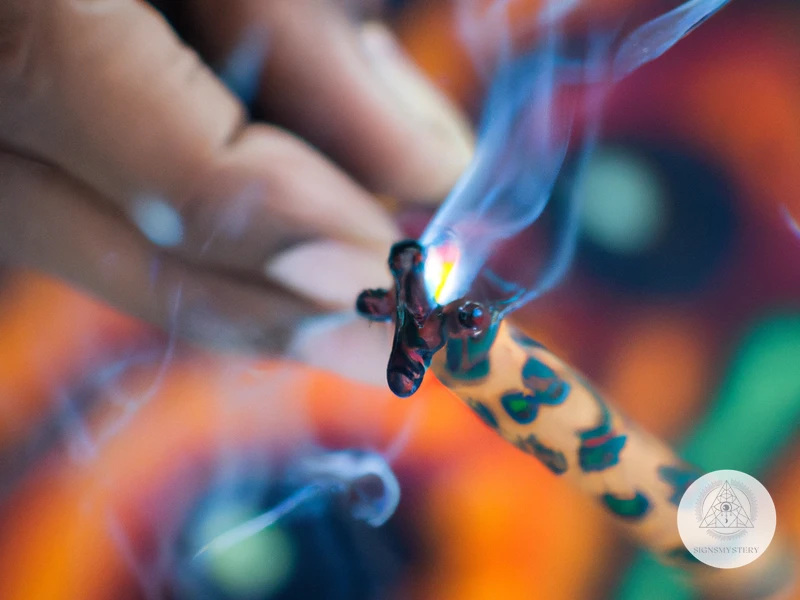
Aboriginal shamanism is deeply rooted in rites and rituals that have been passed down through generations. The Smoking Ceremony is one of the most significant rituals, where a fire is lit using native plants, and the smoke is used to ward off bad spirits and welcome good ones. The Walkabout is a rite of passage for young Aboriginal men, where they leave their hometown and venture into the wilderness to gain spiritual insight and mature into men. The Corroboree is a communal dance ceremony that involves intricate body paint, and is believed to connect the dancers with the spirit world and ancestors. These rituals are still practiced today, and are an important part of preserving the rich cultural heritage of Aboriginal shamanism.
The Smoking Ceremony
The Smoking Ceremony is an important ritual in Australian Aboriginal culture that is performed to cleanse a space of negative energy and evoke the spirits of the Dreamtime. The ceremony involves burning native plants, such as eucalyptus leaves and other aromatic herbs, and using the smoke to purify the space.
During the Smoking Ceremony, participants use a variety of tools to direct the smoke, including feather fans, bullroarers, and clapsticks. The smoke is wafted over people, objects, and buildings, as well as into the four directions.
The ceremony has many purposes and can be performed for different events, such as a birth, wedding, or death. It is also done at the beginning of a new season or after a significant event, such as a major illness or natural disaster.
One of the key components of the Smoking Ceremony is the sacredness of the plants used. They are believed to have powerful healing properties and are used to connect with the spirits of the Dreamtime. Different plants are used for different reasons, and the selection of plants is based on the intention of the ceremony.
The Smoking Ceremony has become increasingly popular in recent years, not just among the Aboriginal community, but also among non-Indigenous Australians and tourists. It is seen as a way of connecting with the country and its spiritual heritage. Many cultural centers and tourist attractions offer Smoking Ceremonies as part of their programs.
It is important to note that the Smoking Ceremony is a sacred ritual and not a form of entertainment. Visitors should participate with respect and follow the guidance of the elders or cultural leaders conducting the ceremony. Participation in the Smoking Ceremony can be a powerful and transformative experience for those who approach it with an open mind and heart.
The Walkabout
The Walkabout is an important rite of passage for young Aboriginal men. It involves a journey of self-discovery and spiritual awakening that can last anywhere from six months to a year. During this time, the young men are separated from their families and are expected to live off the land. They must learn how to hunt, fish, and gather food, as well as how to navigate the harsh and unforgiving Australian wilderness.
The Walkabout is a spiritual journey as well as a physical one. The young men are expected to connect with the land and the spirits that inhabit it. They are encouraged to meditate and to seek visions and guidance from the spiritual world. Many of the songs and dances that are performed during the Walkabout have deep spiritual meanings and are intended to help the participants connect with the land and the spirits.
The Walkabout is also a test of endurance and resilience. The young men are expected to face and overcome many challenges during their journey. They may be forced to survive without food or water for days, or to navigate treacherous terrain and dangerous wildlife. The hardships they face are intended to toughen them up and prepare them for the challenges of adulthood.
The Walkabout is a deeply personal and emotional experience. It is a time for the young men to reflect on their
Subscribe to Our Newsletter
Sign up to receive the latest news and updates.
The Walkabout is a powerful and transformative experience that has played an important role in Aboriginal culture for thousands of years. Today, it is still practiced by some communities, although it has become more difficult due to the pressures of modernization and colonization. Despite these challenges, the Walkabout remains an important part of Aboriginal spiritual life and a testament to the resilience and strength of these ancient cultures.
| Pros | Cons |
|---|---|
| The Walkabout is a powerful and transformative experience | It has become more difficult due to the pressures of modernization and colonization |
| The young men are expected to connect with the land and the spirits that inhabit it | They may be forced to survive without food or water for days, or to navigate treacherous terrain and dangerous wildlife |
| The Walkabout is a deeply personal and emotional experience | – |
| The Walkabout is also a test of endurance and resilience | – |
The Corroboree
The Corroboree is a traditional Aboriginal ceremony where people come together to dance, sing, and connect with the spiritual world. It is a vital part of Australian Aboriginal shamanism because it brings the community together, celebrates culture, and honors ancestors.
During a Corroboree, participants gather around a central fire and perform ritual dances. The dances typically tell stories about the Dreamtime or specific events that have happened in the community. The dancers often wear elaborate costumes and traditional body paint that represent their totems or spiritual beings.
One type of Corroboree that is commonly performed is the “Welcome to Country”. This is a ceremony that is performed on behalf of the traditional custodians to welcome visitors to their land. The ceremony involves speeches, dances, and songs to acknowledge the visitors and the importance of respecting the land and its people.
Another important type of Corroboree is the “Raindance”. This ceremony is performed to ask the ancestors for rain during times of drought. The dancers wear rainmaker costumes and perform specific dances to bring rain. It is believed that the spiritual world will respond to the ceremony and bring much-needed rain to the community.
It’s important to note that the Corroboree is a sacred ceremony and only those who are initiated or invited are allowed to participate. It’s also important to respect the customs and beliefs of the Aboriginal people when attending a Corroboree.
The Corroboree is an essential part of Australian Aboriginal shamanism that provides an opportunity for community gathering, cultural celebration, and connection with the spiritual world. It is a beautiful, sacred ceremony that has been passed down for generations and continues to be practiced today.
The Shamanic Journey
Shamanism plays an important role in Australian Aboriginal culture as it connects the spiritual world with the physical world. Shamans serve as guides, using trance-like states to connect with the spirit world. During the shamanic journey, the shaman enters a state of altered consciousness to communicate with the spirits and receive guidance. The journey is often accompanied by drumming and chanting and can last for hours. Once the shaman has reached their destination, they receive insight and inspiration from the spiritual world, which they can use to help heal and guide their community. This powerful and mystical practice remains an essential part of Australian Aboriginal culture, showcasing the close connection between nature, spirit, and human life.
The Role of the Shaman
The role of the shaman in Australian Aboriginal shamanism was vital, as they were seen as the intermediaries or bridge between the spiritual world and the physical world. The shaman’s connection to the spirit realm allowed them to act as healers, protectors, and mediators between the human and spirit world.
Some of the roles and responsibilities of a shaman in Australian Aboriginal shamanism include:
- Healing: The shaman was responsible for healing the sick, both physically and spiritually. They would use various forms of spiritual medicine and healing practices to help their patients.
- Protection: The shaman was also responsible for protecting their community from harm, whether it be physical, spiritual, or emotional. They would perform various rituals and ceremonies to ensure the safety of their people.
- Guidance: The shaman would often act as a guide for their people, helping them to make important decisions or navigate through challenging situations.
- Divination: The shaman was also responsible for performing divination or fortune-telling. They would use various methods such as reading animal tracks, interpreting dreams, or using signs from nature.
The role of the shaman in Australian Aboriginal shamanism was multifaceted and held great importance in their society. The shaman’s ability to communicate with the spiritual world allowed them to bring healing, protection, guidance, and wisdom to their community.
Connecting with the Spiritual World
Connecting with the Spiritual World is a fundamental aspect of Aboriginal shamanism. Shamans are believed to be intermediaries between the physical and spiritual worlds. They are able to access the spiritual realm through trance states and communicate with spiritual beings to gain insight, guidance, and healing.
There are various methods used by shamans to connect with the spiritual world. One common practice is through the use of music and dance. Aboriginal people believe that music and dance are powerful tools that can help connect the physical and spiritual realms. During ceremonies such as the Corroboree, shamans use music and dance to enter trance states and connect with the spiritual world.
Another method used by shamans is through the use of plants and herbs. Certain plants such as Eucalyptus and Tea Tree are believed to have spiritual properties that can help shamans connect with the spiritual world. Smoke inhalation of certain plants like Sage or even Tobacco was also belief to allow shamans to connect with the spirit world.
Shamans also use various items as aids to connect with the spiritual world. These items can range from sacred stones and crystals to animal bones and feathers. Each item has its own spiritual significance and can be used to help guide the shaman in their spiritual journey.
When a shaman enters the trance state, they are able to communicate with spiritual beings such as the Rainbow Serpent or Wandjina. These beings can provide guidance and insight into a person’s life, and help bring healing to the individual and to the community as a whole. The shaman may also travel to different areas in the spiritual world to retrieve lost pieces of a person’s soul or to communicate with ancestors.
Connecting with the spiritual world is a central part of Aboriginal shamanism. Through various methods such as music and dance, plants and herbs, and sacred items, shamans are able to enter a trance state and communicate with spiritual beings. This communication can provide guidance, insight, and healing that can benefit both the individual and the community.
Legacy and Future
The legacy of Australian Aboriginal Shamanism is complex and multifaceted. The impact of colonization deprived indigenous communities from their land and culture, leading to the disappearance of many shamanic traditions. Aboriginal people were forced to assimilate to Western culture, leading to the loss of language, ideology, and spiritual practices. However, there has been a resurgence in recent years, as indigenous communities have begun reclaiming their ancestral traditions with pride and determination. The preservation of cultural heritage is paramount, and efforts to restore lost knowledge are ongoing. One promising development is the integration of shamanic practices with modern healing modalities, creating a holistic approach to wellness and healthcare. As more people embrace indigenous wisdom, the future of Australian Aboriginal Shamanism looks bright with hope and potential, with the possibility of a spiritual and cultural renaissance that can benefit all Australians.
The Impact of Colonization
The impact of colonization on Australian Aboriginal Shamanism has been significant. With the arrival of European settlers in the late 18th century came a forced conversion to Christianity and an attempted eradication of traditional spiritual practices. The policy of assimilation enforced by the Australian government in the 20th century also dealt a heavy blow to indigenous cultures.
One of the most damaging effects of colonization was the loss of sacred sites and artifacts. Many Aboriginal people were forced to abandon their traditional lands and relocate to government-run missions. This resulted in the destruction of sacred locations and the loss of artifacts, some of which were stolen or sold by collectors.
Colonization also severed the ties between the Aboriginal people and their ancestral spirits. The traditional shamanic practices were viewed as backward and un-Christian by the colonizers, leading to a suppression of indigenous spirituality. This suppression and the loss of spiritual connections had a profound effect on the mental health and well-being of Aboriginal communities and is still felt today.
The impact of colonization on Aboriginal Shamanism led to an erosion of traditional knowledge and practices. Many of the older generation did not pass on their knowledge to the younger generation since they had been forced to abandon their traditions. Fortunately, in recent years, there has been an effort to preserve and revive traditional practices.
Despite these efforts, the impact of colonization on Aboriginal Shamanism cannot be underestimated. It will take time and sustained efforts to truly restore the spiritual practices that were lost due to this devastating period of history.
The Resurgence of Aboriginal Shamanism Today
Aboriginal shamanism, despite being suppressed and nearly eradicated during colonization, is experiencing a strong resurgence today. Indigenous Australians are reconnecting with their cultural heritage and spirituality, and non-Indigenous Australians are embracing the teachings and practices of Aboriginal shamanism.
One reason for this resurgence is the recognition of the importance of traditional knowledge and its preservation. Many Indigenous Australians are working to revitalize their cultures and languages, and shamanism is an integral part of that revival. Non-Indigenous Australians are also recognizing the value of Indigenous knowledge and seeking to learn from Aboriginal elders and shamans.
Another factor contributing to the resurgence of Aboriginal shamanism is the growing interest in alternative and holistic therapies. With the rise in popularity of practices such as meditation and yoga, people are also seeking more spiritual practices. Aboriginal shamanism offers a unique and profound spiritual experience that can benefit those seeking a deeper sense of meaning and connection.
Additionally, the increasing awareness and concern for the environment has sparked interest in the ancient Aboriginal belief in the interconnectedness of all things. The teachings of Aboriginal shamanism emphasize the importance of maintaining a balance between humans and the natural world, and this message is more relevant now than ever before.
The resurgence of Aboriginal shamanism is not only a way to preserve Indigenous cultures and traditions but also offers a means for people of all backgrounds to connect with spirituality and community. As Indigenous and non-Indigenous Australians continue to embrace and revitalize Aboriginal shamanism, it is likely that these ancient practices will continue to thrive and contribute to the cultural diversity and spiritual richness of Australia.
Conclusion
In conclusion, exploring the myths and beliefs of Australian Aboriginal shamanism can provide us with a deeper understanding of their rich culture and spiritual practices. From their creation myths and the Dreamtime, to their totems and taboos, and their spiritual beings like the Rainbow Serpent, Wandjina, and Yowie, we can see how their beliefs are interwoven with the natural world.
Their rites and rituals, such as the Smoking Ceremony, Walkabout, and Corroboree, also demonstrate their deep connection to the land and their ancestors. And through the shamanic journey, we can see how the shaman plays a vital role in bridging the gap between the physical and spiritual worlds.
Unfortunately, the impact of colonization has had a devastating effect on the Aboriginal people and their shamanic practices. However, there is also a resurgence of Aboriginal shamanism today, as many seek to reclaim their heritage and traditions.
Overall, exploring the fascinating myths of Australian Aboriginal shamanism not only shows us the importance of cultural preservation but also reminds us of the interconnectedness of all things in the natural world. We can learn from their practices and beliefs to chart our own spiritual journeys, transcending the boundaries of time and space to connect with the divine.
Frequently Asked Questions
What is Aboriginal Shamanism?
Aboriginal Shamanism is the spiritual practice of the indigenous people of Australia. It involves the belief in spiritual beings, such as the Rainbow Serpent, and the use of rituals to connect with them.
What are some myths associated with Aboriginal Shamanism?
Some myths associated with Aboriginal Shamanism include the belief in creation stories, dreaming and the idea of totems and taboos.
Who are the spiritual beings in Aboriginal Shamanism?
The spiritual beings in Aboriginal Shamanism include the Rainbow Serpent, the Wandjina and the Yowie.
What is the role of the shaman in Aboriginal Shamanism?
The shaman in Aboriginal Shamanism is the spiritual leader who connects the people with the spiritual realm.
What are some of the rituals used in Aboriginal Shamanism?
Some of the rituals used in Aboriginal Shamanism include the Smoking Ceremony, the Walkabout and the Corroboree.
What is the Smoking Ceremony?
The Smoking Ceremony is a ritual used in Aboriginal Shamanism to cleanse and purify people and their surroundings. It involves the use of smoke from burning herbs.
What is the Walkabout?
The Walkabout is a ritual used in Aboriginal Shamanism where young boys are taken into the wilderness for a period of time to learn the culture and spiritual practices of their people.
What is the Corroboree?
The Corroboree is a ritual used in Aboriginal Shamanism that involves music, dance and storytelling to connect with the spiritual realm.
What is the impact of colonization on Aboriginal Shamanism?
Colonization had a negative impact on Aboriginal Shamanism, as it led to the loss of indigenous beliefs and practices.
Is there a resurgence of Aboriginal Shamanism today?
Yes, there is a resurgence of Aboriginal Shamanism today, as indigenous people strive to reclaim their culture and spiritual practices.

